
Updated: Tuesday, May 6, 2014 12:50 AM CDT
Post Comment | View Comments (1) | Permalink | Share This Post
 Hello and welcome to the unofficial Brian De Palma website. Here is the latest news: |
|---|
E-mail
Geoffsongs@aol.com
-------------
Recent Headlines
a la Mod:
Listen to
Donaggio's full score
for Domino online
De Palma/Lehman
rapport at work
in Snakes
De Palma/Lehman
next novel is Terry
De Palma developing
Catch And Kill,
"a horror movie
based on real things
that have happened
in the news"
Supercut video
of De Palma's films
edited by Carl Rodrigue
Washington Post
review of Keesey book
-------------
Exclusive Passion
Interviews:
Brian De Palma
Karoline Herfurth
Leila Rozario
------------
------------
| « | May 2014 | » | ||||
| S | M | T | W | T | F | S |
| 1 | 2 | 3 | ||||
| 4 | 5 | 6 | 7 | 8 | 9 | 10 |
| 11 | 12 | 13 | 14 | 15 | 16 | 17 |
| 18 | 19 | 20 | 21 | 22 | 23 | 24 |
| 25 | 26 | 27 | 28 | 29 | 30 | 31 |
De Palma interviewed
in Paris 2002
De Palma discusses
The Black Dahlia 2006

Enthusiasms...
Alfred Hitchcock
The Master Of Suspense
Sergio Leone
and the Infield
Fly Rule
The Filmmaker Who
Came In From The Cold
Jim Emerson on
Greetings & Hi, Mom!
Scarface: Make Way
For The Bad Guy
Deborah Shelton
Official Web Site
Welcome to the
Offices of Death Records

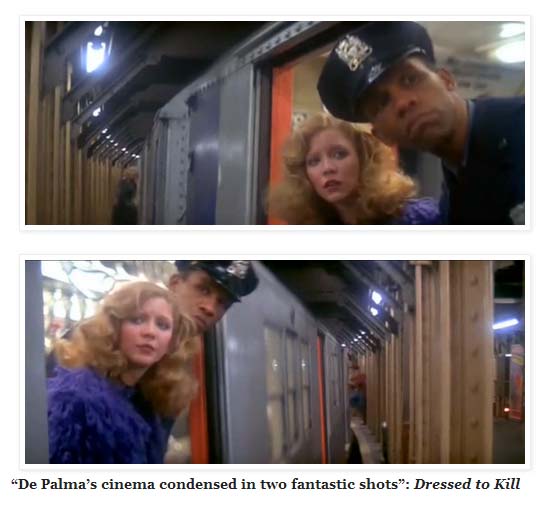
In the meantime, here are some excerpts from the interview, in which the pair share some of the things they discovered while working on the audiovisual essay, and in the process, looking very closely at De Palma's films. They also discuss, with a critical eye, their concept of the audiovisual essay. From Wayward Cloud:
Martin: We are always trying to find the connection between two pieces of film (or rather, snippets of digital files!). We want to find the connecting line, and we want that connecting line to be clear to the person who eventually experiences the piece. We ask ourselves: in going from this scene to the next, is it perfectly clear what we are connecting? Is it a gesture, is it a situation, is it a composition? The challenge is to make this connection as clear as possible, so that it isn’t just a heterogeneous mess of things. If a certain scene doesn’t fit into this line of connections, it has to go – even if we love it.
Álvarez López: This happened, for instance, with a moment from Mission to Mars – I almost cried because we had to let it go. It’s the moment when they have a hole in the spaceship, but they cannot see where it is. They splash some Dr. Pepper and let it go. The astronauts on the inside see where it gets sucked up, and the one on the outside sees it freezing on the hull of the spaceship, and so he can fill up the hole. In some sense, this scene has to do with the idea of blind vision that we explore in the essay; the fluid can also be described as one of the instruments of vision that pop up in almost all of De Palma’s films. But the fragment of film in which the Dr. Pepper is used would have been very confusing in our essay sequence, because it is filmed in a way that the viewer may not recognise its connection with the theme of vision. It is a telling example, but also it’s too different from all the binoculars, glasses and telescopes that De Palma’s protagonists use as visual aids.
Martin: There are too many things going on in that scene, too many instruments and objects floating around for the viewer to know what to focus on and draw the connecting line to. This is something we reflect upon constantly while working on an audiovisual essay: that every single moment in a film is heterogeneous and has many levels – there are always a million things going on. It’s easy to get lost in the richness of certain moments in a film, but if you start to line up these complex and full moments in an essay, you will start to lose the clearness of connection between details that you want to establish. If you want to make a connection between a camera movement in Welles and one Ophüls, you will have to choose precise moments which won’t get the viewer thinking about the motives of the protagonists.
Álvarez López: There were a lot of surprising moments. You see and hear certain scenes so many times that you become aware of a lot of things which you didn’t notice before. You begin to see the details: props in a scene, how a camera movement really works, how complex and well executed the whole mise en scène is. Or, you get to understand the gesture of an actor. For example when we were working on our essay on Rainer Werner Fassbinder’s Martha and James Foley’s Fear, we already knew beforehand what a great actress Margit Carstensen was. But to again and again see the way in which she turns around when the man (Karlheinz Böhm) tells her that he wants to marry her – well, we really saw for the first time how beautiful and complex this movement is. To constantly repeat and manipulate a scene gives you a different knowledge about it.
Martin: I want to give a really concrete example from the De Palma essay. Everyone who has seen some of his movies knows that there are lot of instruments of vision in them: telescopes, binoculars, cameras. We use this evident idea. But another thing which is not so easy to see are all the reflections of light: in mirrors, knives, shining surfaces. We only saw these instances of reflection and resulting blindness, which pop up again and again and build a complex network of associations in a film like Dressed to Kill, by putting our audiovisual essay together.
Álvarez López: When I watched Dressed to Kill for the first time, I really liked the scene where Nancy Allen sits in the subway, and you can see the killer hidden behind the door to the next coach. But what I did not remember, and only discovered by seeing it again and developing the theme of blindness, was the scene when Allen and a policeman look right and left along the train and, just when they turn their heads, the killer enters the train out of their sight. Maybe it is because the following scene inside the subway car is so long and powerful, it obliterates this smaller moment. So we bring it back to consciousness.
Martin: That was the scene that the audience most reacted to when we premiered our audiovisual essay in the Metropolis Kino. And rightfully so: it’s De Palma’s cinema condensed in two fantastic shots. But it’s not something you necessarily retain from a single viewing. Another thing which helps you discover things is the use of music. We did that really intensively while working on De Palma – who himself always takes particular care in his selection of music, collaborating with some of the best composers ever like Bernard Herrmann, Pino Donaggio, Ennio Morricone, Giorgio Moroder and Ryuichi Sakamoto. We tried to use the music in a very specific, not wishy-washy way. Just like slow-motion, the unthinking use of music which gets heaped on top of images is one of the things I dislike most in many audiovisual essays.
The Wayward Cloud: You don’t like slow motion?
Martin: To be honest, we used it on the train scene from Carlito’s Way, because we wanted to bring out the idea that train windows are like the frames of a film strip. But generally we dislike the technique, because in audiovisual essays these days, basically everything is put in slow motion, it drives me nuts. I do not know why people do it, maybe they want to be like De Palma, maybe they think it’s poetic. It becomes an all-over, all-purpose thing. I like the Kate Bush music video for “Wuthering Heights” slowed down to 36 minutes – that one pushes the technique someplace extreme and interesting!
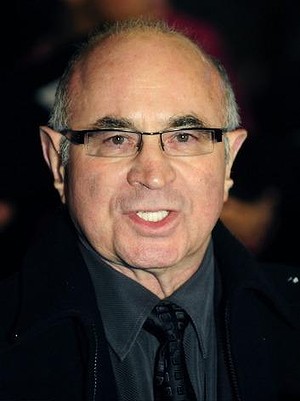 Bristish actor Bob Hoskins died Tuesday after being treated for pneumonia. He was 71. In 1986, Hoskins was signed by Paramount to play Al Capone in Brian De Palma's The Untouchables. However, De Palma had been talking with Robert De Niro about playing Capone, and once De Niro finally committed, Linson asked the studio to pay Hoskins his full salary, which some stories report as $200,000, and others report as $300,000.
Bristish actor Bob Hoskins died Tuesday after being treated for pneumonia. He was 71. In 1986, Hoskins was signed by Paramount to play Al Capone in Brian De Palma's The Untouchables. However, De Palma had been talking with Robert De Niro about playing Capone, and once De Niro finally committed, Linson asked the studio to pay Hoskins his full salary, which some stories report as $200,000, and others report as $300,000.Hoskins' breakthrough role was as a gangster in John Mackenzie's Long Good Friday. (Incidentally, Mackenzie would go on, in 1986, to direct a TV movie out of a screenplay De Palma had been working on for years, Act Of Vengeance.) Hoskins' most famous role was as a private detective in Robert Zemeckis' 1988 smash Who Framed Roger Rabbit. Hoskins' role as an ex-con in Neil Jordan's Mona Lisa (1986) had earned him an Oscar nomination for best actor.
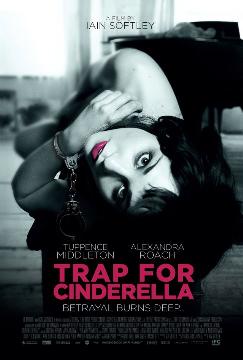 The Record's Amy Longsdorf has a capsule review of Trap For Cinderella in her DVD roundup this week, indicating that the film might be De Palma-esque. Here's what she says:
The Record's Amy Longsdorf has a capsule review of Trap For Cinderella in her DVD roundup this week, indicating that the film might be De Palma-esque. Here's what she says:
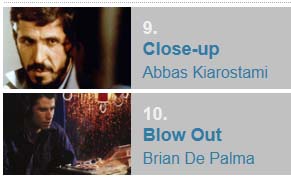 James Schamus, who has worked as screenwriter and producer on several Ang Lee films, among others, submitted a Crtiterion Top 10 list last week that includes Brian De Palma's Blow Out, as well as a shout-out to Chris Dumas' book Un-American Psycho. Although the Criterion site is apparently formatted to list everything in order, Schamus notes in his introduction, "So which top ten shall it be today? Well, in no particular order..."
James Schamus, who has worked as screenwriter and producer on several Ang Lee films, among others, submitted a Crtiterion Top 10 list last week that includes Brian De Palma's Blow Out, as well as a shout-out to Chris Dumas' book Un-American Psycho. Although the Criterion site is apparently formatted to list everything in order, Schamus notes in his introduction, "So which top ten shall it be today? Well, in no particular order..."
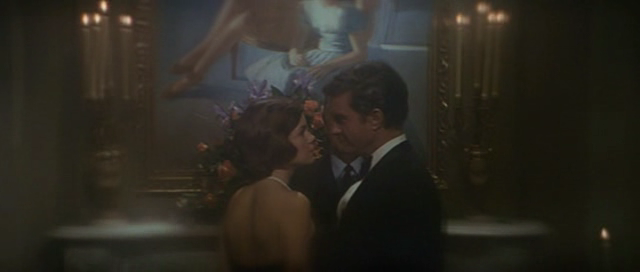
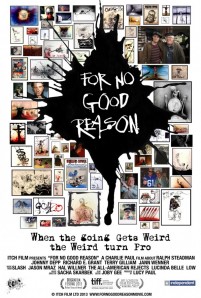 TIME's Richard Corliss posted a review yesterday of Charlie Paul's For No Good Reason, a documentary portrait of artist Ralph Steadman. Steadman's "interlocutor is Johnny Depp," writes Corliss, "a friend of [Hunter S.] Thompson who also starred in Terry Gilliam’s movie of Fear and Loathing in Las Vegas and Bruce Robinson’s film of Thompson’s The Rum Diary. In 1998, Depp and Thompson visited the TIME offices and raised some merry hell (or so I’m told; I wasn’t invited). After Thompson’s death, Depp funded the funeral service: shooting the writer’s ashes from a cannon to the accompaniment of 'Mr. Tambourine Man' (the Bob Dylan song to which the Las Vegas book was partly dedicated). Among the mourner-celebrants were Jack Nicholson, Sean Penn, Bill Murray, Charlie Rose and Ralph Steadman.
TIME's Richard Corliss posted a review yesterday of Charlie Paul's For No Good Reason, a documentary portrait of artist Ralph Steadman. Steadman's "interlocutor is Johnny Depp," writes Corliss, "a friend of [Hunter S.] Thompson who also starred in Terry Gilliam’s movie of Fear and Loathing in Las Vegas and Bruce Robinson’s film of Thompson’s The Rum Diary. In 1998, Depp and Thompson visited the TIME offices and raised some merry hell (or so I’m told; I wasn’t invited). After Thompson’s death, Depp funded the funeral service: shooting the writer’s ashes from a cannon to the accompaniment of 'Mr. Tambourine Man' (the Bob Dylan song to which the Las Vegas book was partly dedicated). Among the mourner-celebrants were Jack Nicholson, Sean Penn, Bill Murray, Charlie Rose and Ralph Steadman."Depp’s appearance in the doc, however appreciated, doesn’t bring much but the patronage of a famous, friendly dude. Nor is Paul quite up to the challenge of synopsizing and illuminating an artist’s long career. As if to prove this is a coffee-house movie and not a coffee-table book, the director uses split screens, animation and rapid montage. But the salient, liveliest parts of For No Good Reason — the title comes from Thompson’s reply when Steadman once asked him, 'Why are we doing this?' — are to be found in the artist’s display of his work and recollections of the eccentrics he met."
In a later paragraph, Corliss discusses the seeming contrasts between Thompson and Steadman, and includes a quote from Brian De Palma that is apparently in the movie:
"While in America [Steadman] got an assignment to cover the Kentucky Derby for Scanlans magazine; the writer would be Hunter Thompson. He quickly realized that he had 'scored a bull’s eye the first time, and met the one man I needed to meet in America.' The two seemed a chronic mismatch. 'To me he was weird,' Steadman says. 'To him, I was weird.' The artist rarely took drugs or alcohol; the writer never stopped. Director Brian De Palma says of Steadman, 'I’ve never met a warmer, generous… He is not his paintings!' Yet Rolling Stone’s Jann Wenner, who hired Steadman to illustrate Las Vegas after another artist dropped out, says that Steadman was the more daring one, Thompson the more cautious."